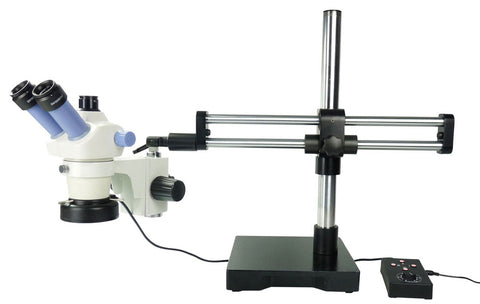
Choosing a soldering microscope for electronics repairs
With electronic components shrinking all the time, a good-quality Industrial Inspection Microscope is quickly becoming a necessity for electronics repair work.
Whether you’re inspecting PCBs or soldering surface mount components, you’ll need a good microscope to make the best use of your talents.
Fortunately, there’s a microscope to suit any budget. Here are the most important qualities to consider when you're looking for a microscope that won’t let you down.
Magnification
As electronic components get smaller, magnification becomes essential if you want to see what you’re doing. However, most electronic repair work needs relatively low magnification.
For SMD soldering or PCB inspection, 2.5–20x magnification will do the job. This is more than enough to work with even the smallest SMT components and do fine pitch rework.
Despite this, you might like to give yourself some wriggle room. A microscope with an upper magnification of 45x will give you the option of attaching a reducing lens that will bring the magnification back down to the 2.5–20x working range while increasing the working distance (which can be a huge help).
Working distance
It may seem obvious but it’s important to have enough vertical room to work in.
You need enough space between your lens and your work surface to comfortably use your tools and equipment, particularly if you’re going to be working for long periods of time.
Working distance isn’t just the amount of space under your lens – the component you’re working on has to be in focus too. This means that the amount of functional space you have to work in depends on the magnification of your lenses.
In order to change your working distance, this is usually done by switching to higher magnification lenses or adding a reducing lens over your objective lens.

Working area
You need a microscope that gives you enough horizontal working area for the components you want to work on.
This may not be an issue for smaller electronics like smartphones, but with motherboards or laptops, you might run into trouble. Some microscopes have a raised working area or a stand right behind the working area. If this is the case, you won’t be able to fit larger electronics into your workspace.

Articulating Arm Microscope Stand
If you think you’ll run into this problem, look into microscopes with a Boom Stand or Articulating Arm Microscope that lets you move your microscope freely in any direction – they provide a much larger working area.

Stereo microscope versus digital microscope
There are two main types of microscopes used for electronics repairs – stereo and digital.
The obvious difference is that with a digital microscope you look at a screen whereas with a stereo microscope you look through an eyepiece.
Whether you use a screen or an eyepiece comes down to personal preference. Some people prefer a screen because it lets them sit for long periods with better posture. Others feel disconnected and prefer to look directly at their work.

Dino-Lite Digital Microscope with Long Working Distance
While both kinds of microscope are perfectly acceptable, stereo microscopes have one advantage for soldering work – depth perception.

Dino-Lite with RK-10A Desktop Stand
They use two eyepieces with separate optical pathways, producing a 3D image that allows you to properly see depth, as opposed to a screen where the image is flat.
Depth perception can be a huge help when you’re putting SMD components onto a circuit board. This is one of the main reasons stereo microscopes are preferred in professional environments.
It’s also worth noting that cheaper digital microscopes can have latency (image delay) issues. This is an annoying image lag that slows your work down. If the time lag is high enough, it can be borderline or very difficult to work with.
Lighting
Lighting is an important part of electronic repair work – you need to be able to see what you’re dealing with.
Digital microscopes tend to come with their own LED lighting, but for stereo microscopes you can also get LED ring lights (which sit in a ring around the lens) and external lights that tend to be articulated and very flexible but require frequent adjusting.

Once again, it’s personal preference. Some people prefer the lack of shadows that comes with a ring light, while others prefer external lights to the side that provide shadows and a sense of depth.
Other things to consider
- Can I afford a microscope? Microscopes suitable for soldering come in all shapes, sizes and costs, each with its own benefits, and ranging from about $400 to many thousands. If you’re looking for the best (but still affordable) microscope for electronics, it’s worth your time to get one that will last you for years to come.
- Do I need a camera? By no means essential but professionally helpful for consulting with colleagues and keeping records.
- Do I need a stand for my microscope? Yes, a sturdy stand that will give you room to work and prevent vibrations is a must. Most low-cost devices come with a wobbly stand, unstable enough to blur your image. Look into models that offer a boom stand or flexible arm that will maximise your working area.
Regardless of the type and frequency of the electronics work you intend to do, there is a microscope that is right for you. Feel free to contact us if you wish to discuss which microscope is best for your application within your budget.
